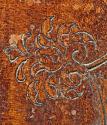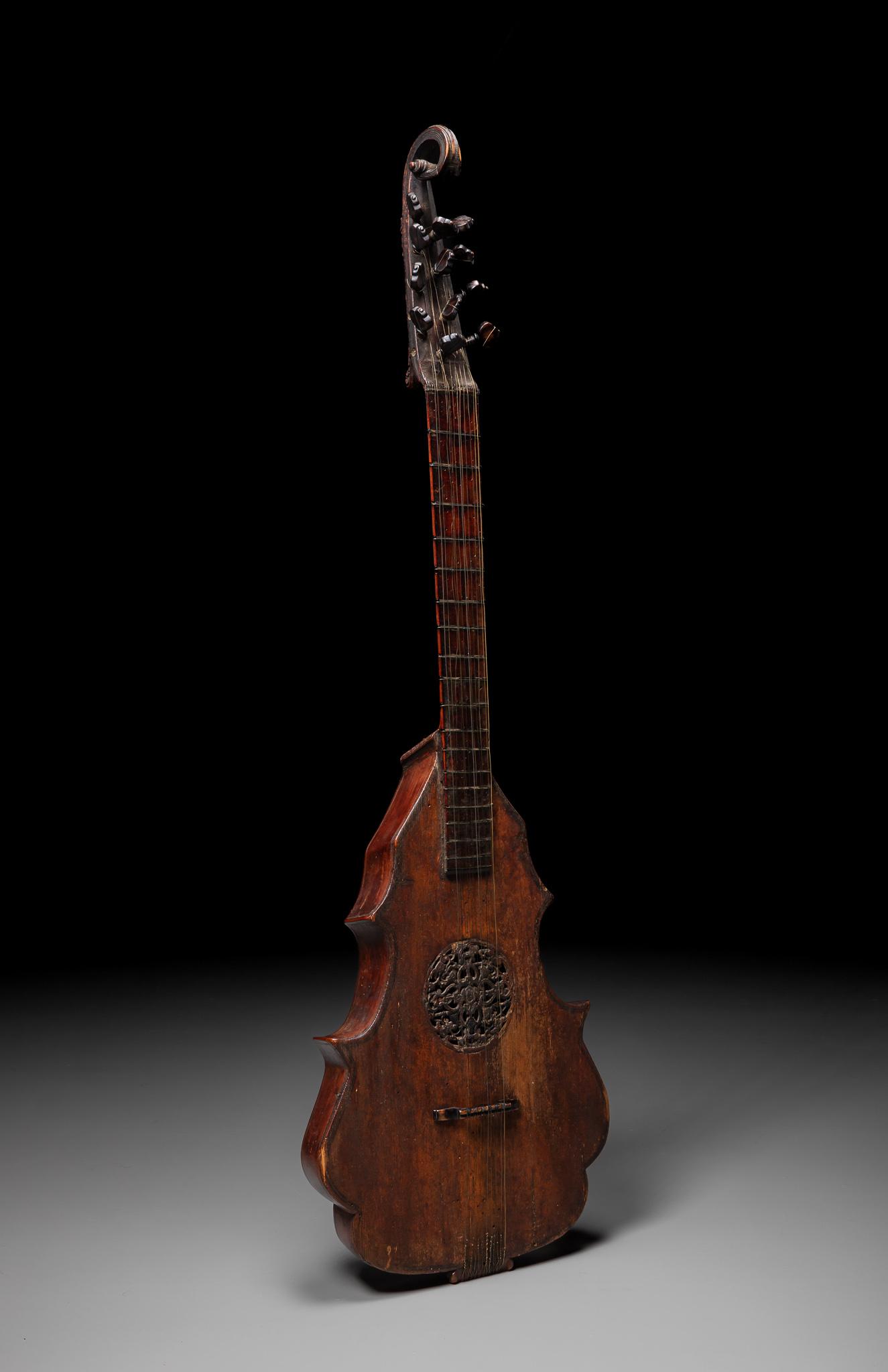Advanced Search
Plucked Strings
Citterns and English Guitars
Cittern
Maker: Rafaello a Urbino
Date: 1538 ca.
Place Made:Urbino, Italy, Europe
Serial No: none
SignedCittern bears a handwritten signature in ink on the side of the neck, near the body, visible under UV light as: Rafaello a Urbino
Markingsnone
DescriptionA small number of Renaissance citterns made in Urbino survive, the earliest of which is dated 1530. Little is known about this Urbino tradition, though one of its masterpieces is this ornate instrument that appears to date from the first half of the 16th century. It bears a signature, Rafaello a Urbino, and perhaps a very faint date, 1538. It is made in a largely medieval manner, with the body and neck carved from a single piece of wood.
Stringing: 10 brass strings
Soundboard: two-piece, quarter-cut spruce or pine: wide grain
Back: one-piece maple, carved from one piece and integral with ribs
Ribs: one-piece maple, carved from one piece and integral with back
Head: maple; open-carved stroll, the scroll itself later; carved grotesque face, hook, incised foliate decoration, and incised lines in imitation of purfling on back
Neck: maple; carved grotesque lion’s head with extended tongue at neck heel incised lines on thinner part of neck, in imitation of purfling; integral with head
Fretboard: maple; brass frets secured to fretboard with ebony inserts inset behind frets (similar to the example by A. Rossi, Urbino, photos in file)
Nut: bone
Bridge: black-stained maple; made by Gary Stewart
Pegs: brown-stained maple; made by Gary Stewart based the Virchi Cittern at the KHM; two additional peg holes on bass side of head, and one on treble side of head, with string wear on head suggesting historical use of pegs at these locations
Rosette: carved hardwood, probably a fruitwood, backed with parchment; foliate design
Varnish: reddish amber varnish.
Linings: unknown
Neck block: unknown
End block: unknown
Top bracing: a softwood lateral brace under the soundhole extends into notches through ribs, such that its triangular ends are visible from the outside of the instrument
Stringing: 10 brass strings
Soundboard: two-piece, quarter-cut spruce or pine: wide grain
Back: one-piece maple, carved from one piece and integral with ribs
Ribs: one-piece maple, carved from one piece and integral with back
Head: maple; open-carved stroll, the scroll itself later; carved grotesque face, hook, incised foliate decoration, and incised lines in imitation of purfling on back
Neck: maple; carved grotesque lion’s head with extended tongue at neck heel incised lines on thinner part of neck, in imitation of purfling; integral with head
Fretboard: maple; brass frets secured to fretboard with ebony inserts inset behind frets (similar to the example by A. Rossi, Urbino, photos in file)
Nut: bone
Bridge: black-stained maple; made by Gary Stewart
Pegs: brown-stained maple; made by Gary Stewart based the Virchi Cittern at the KHM; two additional peg holes on bass side of head, and one on treble side of head, with string wear on head suggesting historical use of pegs at these locations
Rosette: carved hardwood, probably a fruitwood, backed with parchment; foliate design
Varnish: reddish amber varnish.
Linings: unknown
Neck block: unknown
End block: unknown
Top bracing: a softwood lateral brace under the soundhole extends into notches through ribs, such that its triangular ends are visible from the outside of the instrument
DimensionsTotal length: 972.5 mm
Back length: 432 mm
Upper point width, back: 183 mm
Waist width, back: 160 mm
Lower point width, back: 258 mm
Lower bout width, back: 286 mm
Top length: 457 mm
Upper point width, top: 197 mm
Waist width, top: 162 mm
Lower point width, top: 275 mm
Lower bout width, top: 308 mm
Rib height at heel: 63.5 mm/ 63.7 mm
Rib height, at waist: 62.8 mm/ 59.6 mm
Rib height, at endpin: 44 mm
Head length: 280 mm
Head width, top: 20 mm
Head width, bottom: 54.6 mm
Neck length (nut to ribs): 307.5 mm
Neck width, nut: 56.2 mm
Neck width, heel: 50.9 mm
Soundhole diameter: 92.5
Vibrating string length (nut to bridge edge): 615.6
Back length: 432 mm
Upper point width, back: 183 mm
Waist width, back: 160 mm
Lower point width, back: 258 mm
Lower bout width, back: 286 mm
Top length: 457 mm
Upper point width, top: 197 mm
Waist width, top: 162 mm
Lower point width, top: 275 mm
Lower bout width, top: 308 mm
Rib height at heel: 63.5 mm/ 63.7 mm
Rib height, at waist: 62.8 mm/ 59.6 mm
Rib height, at endpin: 44 mm
Head length: 280 mm
Head width, top: 20 mm
Head width, bottom: 54.6 mm
Neck length (nut to ribs): 307.5 mm
Neck width, nut: 56.2 mm
Neck width, heel: 50.9 mm
Soundhole diameter: 92.5
Vibrating string length (nut to bridge edge): 615.6
ProvenanceFrom the collection of Lord Astor at Hever, kept in the music room at Hever Castle, acquired by E. M. W. Paul, London, at the contents sale, Christie's London, 12 November 1963, lot 7. Larry Witten purchased the Cittern from Paul "some time later."
Purchased by the National Music Museum from Laurence Witten family, New Haven, Connecticut, 1984.
Purchased by the National Music Museum from Laurence Witten family, New Haven, Connecticut, 1984.
Terms
Credit Line: Witten-Rawlins Collection, 1984
Not on view
Published ReferencesNMM catalog: _As Good as Gold: The First 50 Years (1973-2023)_. Vermillion, SD: National Music Museum, 2023. (pp. 36, 40-41)
André P. Larson, "Early Italian Plucked Stringed Instruments at the Shrine to Music Museum," Lute Society of America Newsletter, Vol. 20, No. 1 (February 1985): p. 7.
"Utah Students Visit; Restoration Admired," The Shrine to Music Museum Newsletter 13, No. 3 (April 1986), p. 4.
Margaret Downie Banks, "The Witten-Rawlins Collection and Other Early Italian Stringed Instruments at the Shrine to Music Museum," Journal of the Violin Society of America, Vol. 8, No. 3 (1987), pp. 23-24.
Joseph R. Johnson, "The Witten-Rawlins Collection of North Italian String Instruments," American Lutherie, No. 15 (1988), reprinted in The Big Red Book of American Lutherie, Volume Two: 1988-1990, Tim Olsen, editor (Tacoma, Washington: Guild of American Luthiers, 2000), pp. 100-102.
André P. Larson, The National Music Museum: A Pictorial Souvenir (Vermillion: National Music Museum, 1988), inside front cover and pp. 46-47.
Gary M. Stewart, "A Mid-Sixteenth-Century Italian Cittern at the University of South Dakota," CIMCIM Newsletter 14 (1989), pp. 31-32.
"A Treasure from the Witten-Rawlins Collection," National Music Museum Newsletter 34, No. 1 (February 2007), p. 3.
Esteban Marino Garza, "Two Sixteenth-Century Citterns Made in Urbino, Italy: A Comparative Study, M.M. Thesis (Vermillion: University of South Dakota, 2016).
André P. Larson, "Early Italian Plucked Stringed Instruments at the Shrine to Music Museum," Lute Society of America Newsletter, Vol. 20, No. 1 (February 1985): p. 7.
"Utah Students Visit; Restoration Admired," The Shrine to Music Museum Newsletter 13, No. 3 (April 1986), p. 4.
Margaret Downie Banks, "The Witten-Rawlins Collection and Other Early Italian Stringed Instruments at the Shrine to Music Museum," Journal of the Violin Society of America, Vol. 8, No. 3 (1987), pp. 23-24.
Joseph R. Johnson, "The Witten-Rawlins Collection of North Italian String Instruments," American Lutherie, No. 15 (1988), reprinted in The Big Red Book of American Lutherie, Volume Two: 1988-1990, Tim Olsen, editor (Tacoma, Washington: Guild of American Luthiers, 2000), pp. 100-102.
André P. Larson, The National Music Museum: A Pictorial Souvenir (Vermillion: National Music Museum, 1988), inside front cover and pp. 46-47.
Gary M. Stewart, "A Mid-Sixteenth-Century Italian Cittern at the University of South Dakota," CIMCIM Newsletter 14 (1989), pp. 31-32.
"A Treasure from the Witten-Rawlins Collection," National Music Museum Newsletter 34, No. 1 (February 2007), p. 3.
Esteban Marino Garza, "Two Sixteenth-Century Citterns Made in Urbino, Italy: A Comparative Study, M.M. Thesis (Vermillion: University of South Dakota, 2016).
Object number: 03386










































